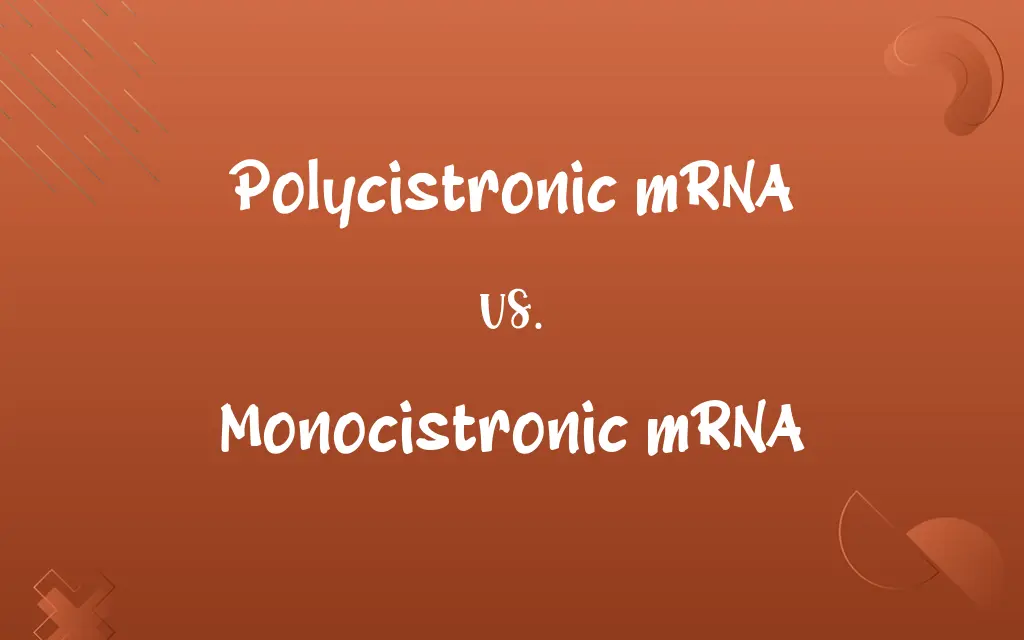Polycistronic mRNA vs. Monocistronic mRNA: Know the Difference

By Dua Fatima & Hifza Nasir || Published on March 2, 2024
Polycistronic mRNA contains multiple genes in one mRNA molecule, translating into several proteins, while monocistronic mRNA carries a single gene, producing one protein.

Key Differences
Polycistronic mRNA, commonly found in prokaryotes like bacteria, encodes multiple proteins within a single mRNA molecule. Each segment of the mRNA is translated into a distinct protein, facilitating the coordinated expression of genes involved in the same pathway. This contrasts with monocistronic mRNA, predominant in eukaryotes, where each mRNA molecule corresponds to a single gene product. This arrangement allows for precise regulation of protein expression in complex organisms.
Hifza Nasir
Mar 02, 2024
The existence of polycistronic mRNA allows bacteria to efficiently respond to environmental changes by simultaneously expressing groups of genes needed for specific functions. In contrast, monocistronic mRNA in eukaryotes supports the intricate regulatory mechanisms required for diverse and specialized cell functions, including differential gene expression and post-transcriptional modifications.
Dua Fatima
Mar 02, 2024
The processing of monocistronic mRNA includes splicing, capping, and polyadenylation, which are not typically required for polycistronic mRNA. These modifications in eukaryotes enhance mRNA stability and translation efficiency, underscoring the differences in gene expression regulation between eukaryotes and prokaryotes.
Dua Fatima
Mar 02, 2024
Operons in prokaryotes are a prime example of polycistronic mRNA functionality, where genes in an operon are transcribed together as a unit in response to environmental stimuli. This is in stark contrast to eukaryotic cells, where each gene's expression is individually regulated, often requiring multiple regulatory elements for precise control.
Dua Fatima
Mar 02, 2024
The evolutionary divergence between prokaryotes and eukaryotes is reflected in their mRNA types. Polycistronic mRNA's efficiency in gene expression suits the simpler, fast-adapting life of prokaryotes, while monocistronic mRNA's complexity supports the nuanced physiological processes of eukaryotes.
Dua Fatima
Mar 02, 2024
ADVERTISEMENT
Comparison Chart
Expression Regulation
Coordinated expression of related genes
Independent expression of each gene
Dua Fatima
Mar 02, 2024
Functionality
Efficient response to environmental changes
Precise, regulated protein production
Hifza Nasir
Mar 02, 2024
ADVERTISEMENT
Polycistronic mRNA and Monocistronic mRNA Definitions
Polycistronic mRNA
Common in prokaryotes.
In E. coli, polycistronic mRNA enables quick adaptation to nutrient changes.
Dua Fatima
Feb 29, 2024
Monocistronic mRNA
Predominant in eukaryotes.
In human cells, monocistronic mRNA facilitates complex gene expression patterns.
Hifza Nasir
Feb 29, 2024
Polycistronic mRNA
Efficient for gene clusters with a common function.
The polycistronic mRNA encoded all proteins necessary for the biosynthesis pathway.
Dua Fatima
Feb 29, 2024
Monocistronic mRNA
Essential for diverse and specialized functions.
Monocistronic mRNAs ensure the specific activation of immune response proteins.
Hifza Nasir
Feb 29, 2024
Polycistronic mRNA
Allows coordinated gene expression.
Bacteria use polycistronic mRNA to simultaneously activate genes for lactose metabolism.
Hifza Nasir
Feb 29, 2024
ADVERTISEMENT
Monocistronic mRNA
Undergoes extensive post-transcriptional processing.
The monocistronic mRNA was capped and polyadenylated before leaving the nucleus.
Dua Fatima
Feb 29, 2024
Polycistronic mRNA
Lacks complex post-transcriptional modifications.
Polycistronic mRNA is directly translated after transcription in bacteria.
Hifza Nasir
Feb 29, 2024
Monocistronic mRNA
Encodes a single protein per mRNA molecule.
Each monocistronic mRNA in humans translates into one specific enzyme.
Dua Fatima
Feb 29, 2024
Polycistronic mRNA
Carries multiple genes for protein production.
The polycistronic mRNA from the operon was translated into several enzymes.
Hifza Nasir
Feb 29, 2024
Monocistronic mRNA
Supports detailed regulation of protein expression.
Monocistronic mRNA allows cells to precisely control the synthesis of hemoglobin.
Hifza Nasir
Feb 29, 2024
Repeatedly Asked Queries
What is polycistronic mRNA?
Polycistronic mRNA is a single mRNA molecule that carries multiple genes, each translated into a different protein, commonly found in prokaryotes.
Hifza Nasir
Mar 02, 2024
What is monocistronic mRNA?
Monocistronic mRNA carries a single gene that translates into one protein, typical in eukaryotic cells.
Dua Fatima
Mar 02, 2024
How do polycistronic and monocistronic mRNA differ in gene expression?
Polycistronic mRNA allows for the coordinated expression of related genes, while monocistronic mRNA enables precise, independent control over each gene's expression.
Dua Fatima
Mar 02, 2024
Why are post-transcriptional modifications important for monocistronic mRNA?
These modifications, including splicing, capping, and polyadenylation, enhance mRNA stability and translation efficiency in eukaryotes.
Hifza Nasir
Mar 02, 2024
Can eukaryotes have polycistronic mRNA?
While rare, eukaryotes can have polycistronic transcripts, typically through mechanisms like viral infection or specific gene arrangements, but it's much less common than in prokaryotes.
Dua Fatima
Mar 02, 2024
What role does monocistronic mRNA play in eukaryotes?
It supports the complex and regulated expression of proteins, allowing for diverse physiological processes and responses to environmental changes.
Hifza Nasir
Mar 02, 2024
Why don't prokaryotes require extensive mRNA processing?
Their simpler cellular structure and the immediate translation of mRNA into proteins negate the need for the extensive post-transcriptional modifications seen in eukaryotes.
Dua Fatima
Mar 02, 2024
How does monocistronic mRNA affect gene expression regulation?
It allows for intricate regulatory mechanisms at the transcriptional and post-transcriptional levels, enabling precise control over protein production.
Shumaila Saeed
Mar 02, 2024
Is there any advantage to having polycistronic mRNA?
Yes, for prokaryotes, it enables a rapid and coordinated response to environmental changes by simultaneously expressing functionally related genes.
Hifza Nasir
Mar 02, 2024
How do operons relate to polycistronic mRNA?
Operons are clusters of genes in prokaryotes that are transcribed together as polycistronic mRNA, allowing for coordinated gene expression in response to environmental stimuli.
Hifza Nasir
Mar 02, 2024
Share this page
Link for your blog / website
HTML
Link to share via messenger
About Author
Written by
Dua FatimaCo-written by
Hifza Nasir







































































